


The Emu (Dromaius novaehollandiae) the national bird of Australia, is the second largest of living birds. Adults average five feet in height but appear much smaller than the ostrich because of their stooped posture. They favor plains and open forests and are swift runners, reaching speeds of 31 mph.
The only surviving emu, the last of the family Dromaeidae, is confined to the wilder plains of Australia, but formerly emus were very abundant in most of Australia, on islands in Bass Strait, on Tasmania, and on Kangaroo Island, in the seas south of Australia. Extinction has overtaken the island populations so rapidly that only a single specimen exists of the dwarf Kangaroo Island emu. Of the other island species,
now vanished, we know practically nothing. Find plush toy Emus at the Jeannie's Cottage Gift Shop.
Emus differ from their near-relatives the cassowaries by being dull-colored, having the head feathered (not covered with a bony helmet), and by living in grasslands (not in deep forest). They are like the cassowaries in being monogamous and, in this respect, differ from the rheas, which are polygamous.
Again like the cassowary, the emu is a powerful swimmer. In the nonbreeding season emus move about in small flocks, but when nesting time arrives, the adults pair off. The female lays seven to twelve or more rough-surfaced, greenish-black eggs in a depression in the earth. The male takes care of the brooding (eight weeks) and attends to the needs of the young. They emerge covered with grayish down, camouflaged with greenish stripes. Chicks are fully grown when they are 12 to 14 months old. Strangely enough, while the female emu may incubate for a short period after she lays the eggs, she is always chased away by her mate, who thereupon takes charge. The female, incidentally, is larger than the male. The female then will mate with other males and produce multiple clutches of eggs.
Emu meat is supposed to be like beef; emus are hunted (and raised) for the oil in their bodies used to make medicines and creams and for meat. Emus feed on vegetable matter, they also eat fruit, berries, and insects including crickets, ants, grasshoppers and certain larvae. They complete to some extent with grazing livestock. They require stones and pebbles to assist the food digestion.
The emu's call, remarkably loud and booming, is probably amplified in a curious pouch which, in both sexes, is connected with the windpipe. The major threat to these birds are dingoes. They are not considered endangered. The life span of an emu is between 10 and 12 years in the wild.
Class: Aves | Order: Casuariiformes | Family: Casuariidae | Genus: Dromaius | Species: D. novaehollandiae



